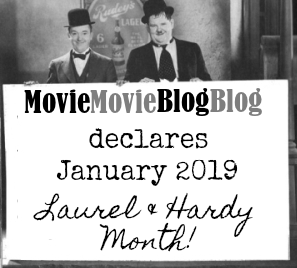The following is this blog’s latest entry in its self-anointed Laurel & Hardy Month. Not sure what that means? Click on the above image to find out!
*
Thus far this month, we have tried to showcase some of the best biographical books about Laurel & Hardy. But some authors, sadly, didn’t aim very high. We wanted to highlight these books as well in order to let the reader beware — and to, let’s face it, give you a derisive laugh or two!
Let’s start with a book that was at least initially well-intended…
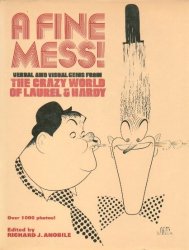
A Fine Mess!, by Richard J. Anobile (1975)
A Fine Mess! might be of limited value to those Laurel & Hardy buffs who literally want to study their heroes’ movies frame by frame. The book’s excerpts are taken from The Crazy World of Laurel and Hardy (1967), a “clip” movie compiled by “Bullwinkle” creator Jay Ward. I’ve never seen this compilation but have often read that it is one of the weaker L&H compilation movies, and this book gives me no reason to think differently.
The weakest element of the book is the style of its “author,” Richard J. Anobile. In the early 1970’s, Anobile made his reputation by reproducing frame-by-frame printed books that compiled scenes from great ’30s comedians such as The Marx Brothers and W.C. Fields. It was inevitable that Anobile would eventually get around to dissecting L&H’s work.
This frame blow-up method was welcome in the pre-video age, but these days it’s hardly the best way to analyze movie comedy, and L&H’s work suffers most by this method. Fields and the Marxes, while they certainly have their visual element, relied heavily on verbiage, so this framing method communicates their comedy fairly well. In the case of L&H’s minimal dialogue, one is left to look mostly at individual sight gags. And unless Anobile could have printed the 24 frames that each second of sound film contains, his method couldn’t possibly illustrate the joy of an Ollie double-take or a Stan eye-blink of cognition.
One is left to turn the pages at a rapid rate a la an old “flip book” and try to imagine the movie as it really ought to be. Laurel and Hardy’s comedy isn’t completely obliterated by Anobile’s method, but still, one is better advised to look for the McCabe or Skretvedt biographies, which distill L&H’s comedy far less clinically and more lovingly.
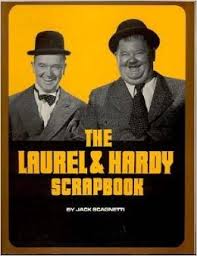
The Laurel & Hardy Scrapbook, by Jack Scagnetti (1976)
Virtually the only virtue of The Laurel & Hardy Scrapbook is that it has some very nice casual photos of Stan and Babe that I’ve not seen anywhere else. Otherwise, the book contains: the standard information on how the boys teamed; misinformation in some photo captions (for example, claiming that Stan’s finger-lighting trick from Way Out West was prefaced by Stan’s pouring gasoline on his fingers [kids, don’t try this at home!!]); and worst of all, “promotional” material for Larry Harmon’s abysmal L&H cartoons and a short-lived L&H pizza-restaurant chain. The best L&H books are a labor of love; this one is a labor to endure.
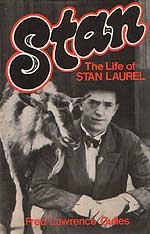
Stan: The Life of Stan Laurel, by Fred Lawrence Guiles (1980)
This book is as far removed from a reverential, John McCabe-type biography as L&H’s Hal Roach films are from their Fox features. Guiles has achieved the dubious goal of painting Stan Laurel as the typical womanizing, alcoholic, cold-blooded Hollywood idol — much, in fact, like the silent-film-star stereotype whom Laurel fan Dick Van Dyke portrayed in Carl Reiner’s The Comic (1969). Guiles admits in his introduction that he relied heavily upon the memories of Laurel’s ex-wife Ruth, and predictably, the ex doesn’t paint a pretty picture.
Guiles also takes great liberties in making some of his points. One example is his supposition that The Music Box came about because Stan’s ideas had dried up and one of his gagwriters suggested, “in desperation,” that L&H remake their silent hit Hats Off. (Considering that the movie went on to become their most celebrated, award- [their only Oscar] and otherwise, all artists should have such dry spells.)
The book is quite readable but finally ends up as another attempted debunking of a comedy great. Since Laurel was among the first to point out his own flaws, this attempt to display every one of them often comes off as strident. Though the author acknowledges John McCabe’s help in assembling his story, one imagines McCabe himself regretting the collaboration.
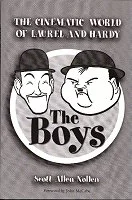
The Boys: The Cinematic World of Laurel & Hardy, by Scott Allen Nollen (1989)
If Charles Barr’s book Laurel & Hardy is academic analysis that makes sense, The Boys is the antithesis. Despite the book’s dedication “to all people who have laughed at a Laurel and Hardy film,” and an attempt at legitimacy by sporting a foreward by seminal L&H biographer John McCabe, most of the book comes across as the same sort of literary pretentiousness that Laurel himself poo-poos in McCabe’s foreward. It offers a few interesting insights, but not enough to actively seek out the book. Far from reflecting the author’s admiration for L&H, the book seems mostly intent on showing its author in a bright academic light (Look, Ma! My own book!), and it mostly fails.

